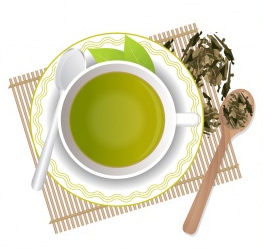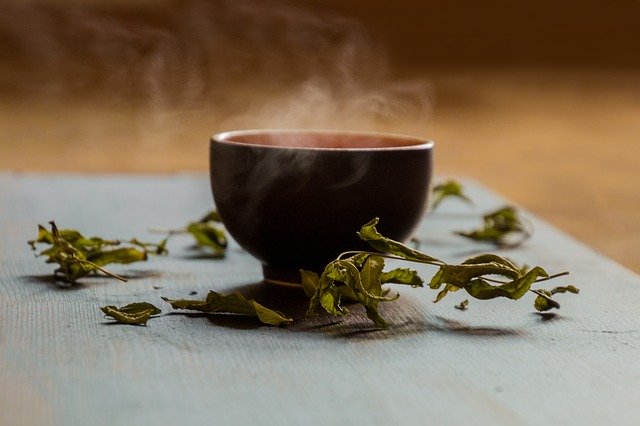
Green tea has certainly become a popular beverage around the world. It is estimated that it makes up about 15 percent of all tea consumed. While the number of people who drink the brew has certainly increased with time, few people know about the many benefits of green tea. To gain a deeper insight into green tea, here are the fundamental facts that you should know:

Contents
To begin with, let’s take a closer at what green tea is. Although it might seem far removed from black tea, the leaves used to brew both beverages are sourced from the same plant. This is the Camellia sinensis. As such, green tea is considered a “true tea”.
The main variance between green and black tea is the preparation method. In short, green tea undergoes less processing which results in a different color and taste. It is also the production process that is responsible for specific green tea nutrition.
Green tea originated in China and is believed to have been a part of its culture for over 3000 years. In fact, it was green tea that was first consumed by the Chinese population. So, the historical references to tea were actually regarding green tea.
In the early days, green tea leaves weren’t brewed. Rather, they were chewed and eaten for recreational purposes. It wasn’t until around 2737 BC that the leaves were boiled and drunk. Legend has it that it was Emperor Shennong who first realized that the leaves could be made into a tea.
As the story goes, the Emperor and his convey were resting when some tea leaves blew from a nearby plant and landed in some boiling water. The Emperor found the drink to be incredibly refreshing and ordered his convey to continue preparing it for him.
Between the 3rd and the 6th century, tea went from being a luxury beverage to one that was readily available to the public. By the time of the Tang dynasty, tea was a common drink and tea ceremonies were held as well.
The drink likely spread to Japan by way of Buddhist monks. As Buddhism flourished in Japan, a greater number of monks visited China to learn more about the religion. In addition to the teachings, they also brought green tea back with them.
With time, tea spread to many other Asian countries including Taiwan, India, and Sri Lanka. To date, however, China and Japan remain the world’s largest producers of green tea.
Since it is the production process that truly sets green tea apart, let’s take a closer look at what it involves. It should be noted that the exact steps can vary, depending on whether the tea is being produced in China or Japan:
Once the leaves are plucked, they are dried. In China, this is done through pan-frying, while in Japan, the leaves are steamed. After this step, certain enzymes are deactivated and the process of fermentation and oxidation is halted. This is what allows the leaves to maintain their green color as well as a distinct taste profile.
Then, the leaves are rolled and shaped. In most plants, this step is carried out by machines. However, in China, the premium leaves are still hand-rolled. They are often dried and rolled a couple of times. In Japan, this step might be repeated numerous times.

Going by the look of green tea leaves and the resulting brew, it is natural to assume that the drink will taste ‘leafy’ or ‘grassy’. While this is certainly true for some blends, it doesn’t accurately describe all green teas. The truth is that this type of tea can actually have a rather complex flavor profile, depending on how it is manufactured.
Therefore, the green tea you drink can have any one of the following notes: Sweet, Bittersweet, Vegetal, Buttery, Nutty, Floral, Fruity, Earthy, and Herbaceous.
It should also be noted that the ‘texture’ of green tea has an impact on your tasting experience. For instance, a tea that can appear soft and creamy may have a sweeter or buttery taste to it. On the other hand, a more refreshing or sparkly taste may elicit a grassy or floral flavor.
If you have ever tasted green tea, you will know that the flavor can vary quite a bit. This is because the taste of the brew varies according to the following factors:
While all green tea leaves come from the same type of plants, the manufacturing process can result in teas that look and taste different. Of course, there are cultural variants as well. Here are the most common Chinese and Japanese variants:
There are two types of Chinese green tea:
There are several types of Japanese green tea. The differences often stem from just how long the leaves are steamed.
Related Article
Rounding Up the Winners: The Best Matcha Powder for Your Drinks
This beverage is so popular because of the numerous benefits of green tea. Of course, there are a few myths involved as well. Thus, it is important to know about the precise advantages of this brew.
Oxidative damage caused by free radicals is one of the leading causes of cancer. This is why it is good news that there is an abundance of green tea antioxidants in your brew. In particular, green tea is rich in catechins.
It would appear that these catechins have two useful effects on cancer. To begin with, the anti-oxidative functions limit cell damage. At the same time, catechins have been found to cause cell death in tumors, producing a more positive impact.
Green tea extract benefits extend to the brain as well. Research suggests that catechins can act as neuroprotective agents. As a result, they can greatly reduce the risk of degeneration of various brain cells and pathways.
In doing so, green tea may be actively able to cut down on the chance of you developing diseases such as Alzheimer’s and Parkinson’s. While more studies need to be conducted, it does appear that green tea can slow down or even prevent dementia altogether.
Type 2 diabetes is becoming a serious issue for people around the world. The condition mainly stems from elevated blood sugar levels due to insulin resistance or low production. This is why it is impressive that green tea is said to have an “anti-diabetic effect” and can help to naturally lower blood sugar levels.
There is some evidence to show that green tea can prevent diabetes. In a study, it was revealed that people who drank green tea on a regular basis were around 42 percent less likely to develop the disease.
In the right amounts, caffeine can actually have a positive impact on your health. It can boost cognitive performance and improve attention as well as alertness. It can also boost endurance and stamina. And by increasing your metabolism, caffeine can even aid with weight loss.
Now, the problem with most beverages that contain caffeine such as coffee and black tea is that the concentration is a little too high. As a result, you are bound to experience issues such as jitteriness and sleep problems in addition to all the positive effects.
With green tea, however, this isn’t an issue. This is because green tea has a much lower caffeine content – around 24mg to 40mg. This means that you can avoid the side effects and only enjoy the benefits of caffeine.
Cardiovascular diseases are the leading cause of death in the developed world. The main causes of this disease are high cholesterol levels and elevated blood pressure. Fortunately, green tea has shown that it can help with these elements.
Consuming regular amounts of green tea can help to lower both your total cholesterol levels as well as your LDL cholesterol levels. What’s more, it can even bring blood pressure to a normal range. In short, green tea drinkers are around 31 percent less likely to develop cardiovascular disease.
Since green tea plays a significant role in reducing the risk of developing some of the most fatal diseases in the world, it stands to reason that it has an impact on life expectancy as well.
There are statistics to back up this presumption. In Japan, it was shown that women who drank several cups of green tea were up to 23 percent less likely to die from any disease. For men, this risk dropped by 12 percent.
If you want to lessen your number of visits to the dentist, then green tea can help with this as well. Experts have found that the drink can inhibit the growth of bacteria known as streptococcus mutans. These germs are responsible for tooth decay.
On a daily basis, drinking green tea can also reduce plaque build-up on the teeth. As such, it will be easier to manage your oral health on all fronts. Finally, green tea can help to get rid of bad breath as well.
For the most part, green tea is quite safe for children and adults alike. This, of course, is provided that you drink moderate amounts. It is often best to stick to around five cups or less to avoid the risk of an adverse reaction. Pregnant or breastfeeding mothers should lower their intake during these periods due to the caffeine content.
In most instances, it is the caffeine content that results in green tea side effects. This is why individuals with anxiety disorders, bleeding disorders, anemia, glaucoma, and IBS should be careful. It is best to speak with your doctor before drinking green tea.
If you have liver disease, green tea extracts can be especially dangerous. Thus, you may want to avoid the beverage if you have been diagnosed with any kind of liver issues. Or, get your doctor’s permission before consuming the tea.
It is clear that there is more to green tea than you might have expected. Thus, picking the perfect blend may not be quite as straightforward. To ensure that you get the best possible quality, follow these tips:
There is no denying that green tea bags make brewing a great deal easier. Whenever possible, though, you should pick loose leaves. To begin with, loose leaves have more nutrients in them, increasing the number of health benefits.
At the same time, loose leaves are often of better quality. In addition, they are more capable of fully releasing their taste and aroma into the water. They will taste better as a result.
It should go without saying that a higher antioxidant content is better for you. Now, there may be some brands that release this information. If not, you should be able to read scientific reports that will show you just which type of tea has the best content.
If you are drinking green tea for health benefits, then it makes sense to consider an organic version. You can be certain that there were no harmful pesticides used in the growing process. Thus, none of these ingredients will make their way into your cup.
Green tea has a rather short shelf-life. Due to this, it is important to always check the freshness of the leaves before buying them. While you are checking the label, it is a good idea to consider whether the leaves were picked during the first harvest or the second. The first harvest is during March and April and produces a better tasting tea.
As mentioned, green tea has a short shelf-life. Therefore, you will need to consume it within six months to a year after your initial purchase. This isn’t all, though. You must also store the leaves properly so that they maintain their freshness for this duration.
In particular, the leaves shouldn’t be exposed to direct sunlight, high temperatures, humidity, and open air. Since the green tea leaves are quite adept at absorbing smells, you should be careful about what other ingredients are stored nearby. So, make it a point to store your green tea in a cool, dark area.
Have you ever tasted green tea and thought it was too bitter? Well, this poor taste was probably due to incorrect brewing methods. To learn the right way to brew it, see below for the steps you should follow:
Most experts would advise you to use pots and cups made from certain materials for the best brew. These include stainless steel, ceramic, glass, porcelain, or clay. Using aluminum or plastic may alter the taste of the drink.
Hard water or water that contains numerous minerals can affect the taste of the tea. As such, it will not have a pleasing taste. To prevent this, use spring water or water that has been filtered well. Also, use cold water to make green tea.
Green tea is quite delicate. Therefore, if you use water that is too hot, the leaves will release a bitter taste, making the beverage difficult to drink. It is best to heat the water to between 160°F and 180°F. If you can’t keep track of the temperature, simply allow boiling water to cool for a while before adding the leaves.
As a rule of thumb, add 2 grams of green tea leaves to every 8 ounces (236 ml) of water. Since the weight of leaves can vary from one producer to another, it is best to weigh them with each brand. This will produce a better brew.
If the green tea leaves are from the first harvest, then you will not need to steep them for too long. In this instance, steeping the leaves for around 30 to 60 seconds is enough. For more robust teas, you can steep the leaves for two to three minutes, but not longer.
Here are some interesting facts about green tea to wrap things up:
It is clear that green tea is an incredibly complex beverage with plenty to offer. By learning more about this drink, you can better appreciate its flavor, benefits, and proper brewing method. This will help you enjoy your cup of green tea to the fullest.
If you love green tea and all associated beverages, head to our Pinterest page. You can tons of recipes, guides, and lots more.
